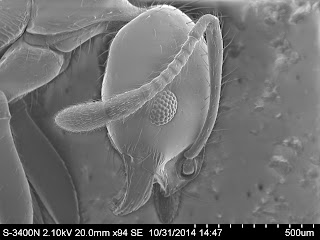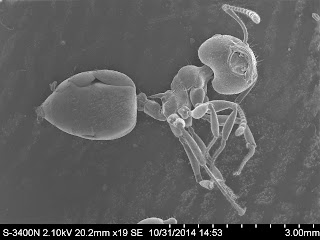Dissecting Microscope
A closer look then the naked eye alone; the dissecting microscope allows us to get a closer and in depth view of larger specimens in natural state.
Fire Ant Full Body
Ants are tiny; they consist of thousands of different species able to be seen by the naked eye but under the microscope reveals so much more. Here in full view of the ant we can see the entirety of its head, thorax and abdomen which is commonly found among insects.
Fire Ant Thorax
The thorax or mesosama is the mid section of any insect, being the primary
connection between the legs, head and abdomen. The spines on the
ant's thorax shows indication that this ant's job is most likely to protect the
colony as a guard and also general labor around the mound.
Fire Ant Head
The ant's head like many animals in general is the control center. An ants head consists of a pair of compound eyes, mandibles, and antennas.


Fire Ant Abdomen
The abdomen of the insect is the opposite side if the head and last piece of its body. The gaster shown here is a highly important part of the ant for it contains all of its organs and functions for the ant to live. The gaster contains the ants heart, intestines stomach and poison glands for the stinger at the end.

Fire Ant Family
The ant is an eusocial insect with the same family of wasps and bees. Fire ants live in a colony that stems from one queen that after mating finds a nice suitable area and burrows deep in the ground. When the queen has reached a comfortable depth she will then tear off and feed on her own wings for her soon to be larva inside. Never to fly again the queen will lay eggs, a start to her colony with ants ranging in sizes from workers, farmers, and caregivers being mostly of girls for males are only born when needed during matingseason.
Scanning Electron Microscope TM-1000
A powerful microscope going further the pure eyesight into small and minute details that we may have never realized were there.Fire Ant Antenna
The ant's antennas can truly be thought of as the its hands. They are connected to the head by the scape which is the long segment before broken down into smaller areas called funiculus. Shown is the very end of one antenna which ants use to feel, sense and detect their surroundings. The hairs that cover the funiculus is whats adds to the detection and feeling power of the antenna pair.
Fire Ant Head
This is the under view shot of the ants head and mandibles which can be seen here can contract and are used as another pair of hands for the ant. The jaws are used from moving obstacles and solving route problems to holding down prey and having a grip on the task the ant may be doing..jpg)
.jpg)
Fire Ant Abdomen
The abdomen, dominantly being the gaster in this scenario besides vital organs for ants life also contains the poison glands the are injected through the stinger. Seemingly small but harmful is an ants stinger, know the hold down its victim with their jaws and pierce with the poison.
Fire Ant Eye
Ants like the cousins the bee and wasps along with even more insects such as butterflies and flys have compound eyes. Compound eyes are eyes that are made up from hundreds of tiny lenses put together and form an image; they also on the top of their heads have three ocelli or simple eyes used to detect light levels. Shown here to be seemingly hexagonal each lens is actually circular, although even with so many lens the ant can detect movement great but has very poor image resolution in whole.
Fire Ant Legs
There are six legs all connected to the thorax of an ant and obviously used for mobility. The tarsal claws and tibial spurs on the legs can be seen as the feet and knees, When ants crawl and travel over all types of terrain these built in grappling hooks help the ant maneuver and climb with ease grasping to what it can.Scanning Electron Microscope S3400
An even more powerful microscope using the same concept of the previous microscope again of using electrons through a vacuum the hit the target, bounce aback and allow us to see what was hit at a greater magnification.
Fire Ant Head
Fire Ant Full Body
Fire Ant in Profile, Head, Thorax, and Abdomen/Gaster.
.


Ant Abdomen
Also follows up on the plates that make up the Gaster in higher Resolution. Area shows Postpetiole III, IV, V, VI, VII, Tergite, and Stemite
Fire Ant Thorax
Pronotum, Mesothoracic Spiracle,
Mesonotum, Propodium, and Propedial Spiracle from top of Abdomen going
down.
Fire Ant Head
Head, Exterior showing Compound Eye, Antenna,
Mandibles and Mouth. Internal, Brain, Nerve Cord begins, and Food Pouch.
Fire Ant Gaster
External, Abdomen, Gaster Sting, and Rectum.
Internal, Poison Gland, Crop, Second Stomach as well as ending of Nerve
Cord.
Fire Ant Leg
Middle Left Leg Tibia shown with Fine Thin Hair


Fire Ant Eye
Ants again have compound eyes which shown here give a better look at the spherical look of each individual lens. This is due to high number of lenses light is unable to reach and fully view out of each eye, this may seem like a draw back but in trade ants have a very high viewing angle of the land with this feature. This allows ants to be detect very fast movement but not completely see what is there without further inspection with antenna.




.jpg)
.jpg)
.jpg)
.jpg)







Fire Ant Thorax
Lower Abdomen, Petiole and Post Petiole